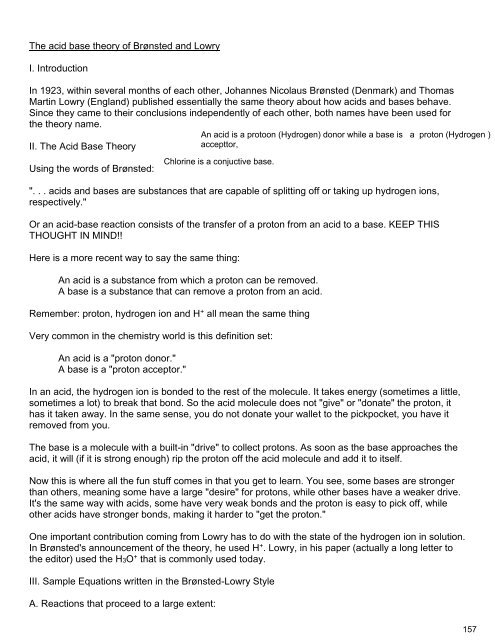Create successful ePaper yourself
Turn your PDF publications into a flip-book with our unique Google optimized e-Paper software.
The Learning Goal for this section is:<br />
The student will learn what are the different ways chemists define aids and bases, what the pH of a solution means and<br />
how chemist use acid-base reactions<br />
Acids and Bases<br />
The Observable Properties of Acids and Bases<br />
The words acid and alkaline (an older word for base) are derived from direct sensory experience.<br />
Acid Property #1:<br />
The word acid comes from the Latin word acere, which means "sour." All acids taste sour. Well<br />
known from ancient times were vinegar, sour milk and lemon juice. Aspirin (scientific name:<br />
acetylsalicylic acid) tastes sour if you don't swallow it fast enough. Other languages derive their word<br />
for acid from the meaning of sour. So, in France, we have acide. In Germany, we have säure from<br />
saure and in Russia, kislota from kisly.<br />
Base Property #1:<br />
The word "base" has a more complex history (see below) and its name is not related to taste. All<br />
bases taste bitter. For example, mustard is a base. It tastes bitter. Many medicines, because they are<br />
bases, taste bitter. This is the reason cough syrups are advertised as having a "great grape taste."<br />
The taste is added in order to cover the bitterness of the active ingredient in cough syrup.<br />
Acid Property #2:<br />
Acids make a blue vegetable dye called litmus turn red.<br />
Acids are on the bottom and bases are at the top.<br />
And 7 is nuetral.<br />
Base Property #2:<br />
Bases are substances which will restore the original blue color of litmus after having been reddened<br />
by an acid.<br />
Acid Property #3:<br />
Acids destroy the chemical properties of bases.<br />
Base Property #3:<br />
Bases destroy the chemical properties of acids.<br />
Neutralization is the name for this type of reaction.<br />
Acid Property #4:<br />
Acids conduct an electric current.<br />
Base Property #4:<br />
Bases conduct an electric current.<br />
Acids more hygrogens. BAsese more hydroxides.<br />
GIving hydrogen is Acid. HYdroxide being given off its a base.<br />
Acid turn blue litmus red . Taste sour. ACids vorrode metals<br />
and they aree postively charged hydrogen ion H^+<br />
BAses;<br />
They turn litmus blues. Taste bitter , nehgativey chraged<br />
hydroxideions . IT also feel slippery .<br />
Most hand soaps scaps and drain cleaners are bases.<br />
Strong bases are caustic.<br />
We use soap with bases because they get rid of<br />
This is a common property shared with salts. Acids, bases and salts are grouped together into a<br />
category called electrolytes, meaning that a water solution of the given substance will conduct an<br />
electric current.<br />
Non-electrolyte solutions cannot conduct a current. The most common example of this is sugar<br />
dissolved in water.<br />
154



